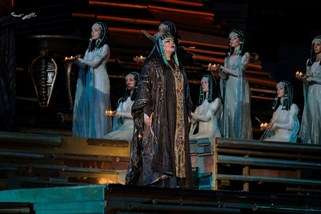|
Back
Amneris Reigns Supreme Verona
Arena
06/23/2018 - & June 28, July 8, 10, 14, 19, 22, 27, August 2, 5, 7, 11, 19, 23, 29, September 1, 2018
Giuseppe Verdi: Aida
Anna Pirozzi*/Kristin Lewis/María José Siri/Susanna Branchini/Hui He (Aida), Violeta Urmana*/Carmen Topciu/Judit Kutasi/Anita Rachvelishvili (Amneris), Yusif Eyvazov*/Marco Berti/Carlo Ventre/Gregory Kunde/Walter Fraccaro (Radamès), Luca Salsi*/Sebastian Catana/Ambrogio Maestri/Amartuvshin Enkhbat/Federico Longhi/Gocha Abuladze (Amonasro), Vitalij Kowaljow*/Rafal Siwek/In Sung Sim/Marko Mimica/Gianluca Breda (Ramfis), Romano Dal Zovo*/Roberto Tagliavini/Enrico Marchesini (Il Re), Francesco Tiburzi*/Arina Alexeeva (Sacerdotessa), Antonello Ceron*/Carlo Bosi (Un messaggero), Beatrice Carbone*, Petra Conti*/Alessia Gelmetti/Gabriele Corrado*/Mick Zeni/Davit Galstyan (Dancers), Ballo dell’Arena di Verona
Coro dell’Arena di Verona, Vito Lombardi (Chorus Master), Orchestra dell’Arena di Verona, Jordi Bernàcer*/Daniel Oren/Andrea Battistoni (Conductor)
Franco Zeffirelli (Stage Director & Set Designer), Anna Anni (Costumes), Vladimir Vasiliev (Choreography)

V. Urmana (© Foto Ennevi/Fondazione Arena di Verona)
Franco Zeffirelli’s massive sets centered around an all-purpose pyramid, an oddity in some of the scenes, such as the celebration of Egypt’s victory over the Ethiopians. A pyramid is a funereal structure that could be plausible in the background of the Nile scene and acceptable in the final scene when Radames is entombed, though it’s too honourable a sepulcher for a man condemned to death for treason. The massive pyramid filled the Arena’s huge stage. Statues of Pharaohs more reminiscent of art primitif than of Egyptian art complemented Zeffirelli’s pyramid.
Anna Anni’s costumes for the main protagonists were beautiful and colourful, with an air of authenticity. The costumes for the populace were a strange hybrid between biblical and contemporary Arabian garb, in contrast to the Egyptian courtiers’ costumes which more conventionally ancient Egyptian. Obviously this was deliberate and meant to signify oppressive rule and the court’s distance from the common man. The relevance to this innovative detail to the plot isn’t obvious. Likewise, the slave girls and priestesses were mysteriously dressed in Disneyfied Chinese dresses, more Turandot than Aida. The harmony of the blue, turquoise and white colours of the dresses on the Arena’s vast stage may be the reason. However, the main priestess’s screaming red dress was more Folies Bergère than Ancient Egypt. Vladimir Vasiliev’s choreography was impressive, though often too athletic, and attempts at creating an Egyptian style not successful. The Nubian dances were well-choreographed but rather outdated, seeming as an old-fashioned racist caricature of Africans.
The cast was dominated by Violeta Urmana as Amneris, in a class of her own. The Lithuanian soprano has a powerful instrument with a wide range, from a rich mezzo to a dramatic soprano. Although it was announced prior to the third act that she was indisposed, there was no hint either before or after the announcement of any vocal fatigue. Urmana has the right voice for the role, able to manage the high notes, especially in the Act IV Judgement Scene. Soprano Anna Pirozzi was an unconvincing Aida, despite a healthy lirico spinto voice and some beautiful pianissimi that excited the audience. The final note of “O patria mia” was not sustained long enough. The main problem was her obvious lack of stage presence, exacerbated by the Arena’s gigantic stage. The other deficiency was relatively sloppy phrasing, especially glaring when juxtaposed with Urmana in the Act II duet, “Fu la sorte dell’armi a’ tuoi funesta.” Tenor Yusif Eyvazov is a stentorian Radames. His voice is huge and his high notes well supported. The timbre is not unpleasant but it not “Italianate,” a major setback for such a role. His Act I aria “Celeste Aida” was beautifully sung despite the unusual timbre. Baritone Luca Salsi could have been a great Amonasro. His baritone is appropriately Verdian, but the style was not nuanced, with a tendency to sing forte most of the time. Basses Vitalij Kowaljow and Romano Dal Zovo as, respectively, Ramfis and the King of Egypt, had beautiful instruments and did justice to their roles. Dal Zovo and Urmana were the only cast members that were convincing as Royals in their posture and poised movement. The orchestra played with gusto under the baton of Jordi Bernàcer. The conductor paid special attention to the needs of his singers, especially Anna Pirozzi, for her two major arias. The trumpets were off key a couple of times in the rousing Triumphant Scene.
Zeffirelli’s staging was, as always, conventional without any extravagant innovations, which is the best possible staging for a general audience. Beauty is this stage director’s prime objective, and despite the inauthentic aspects of the sets, costumes and choreography, the production was certainly visually appealing. The public adored the huge sets and ornate costumes, and enthusiastically showed their appreciation. A minor oddity was the ridiculously small number of Ethiopian prisoners in the Triumphant Scene in Act II: a mere dozen captives in a sea of courtiers, slaves and dancers. Compared to the previous evening’s Carmen, the event was well-organized with smooth audience management. Mercifully, there was just one intermission for this four-act opera, leading to a relatively short performance of approximately three hours.
Ossama el Naggar
|